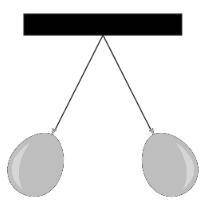PLEASE ANSWER
A student hangs two inflated balloons from 1-meter strings so that they to...

PLEASE ANSWER
A student hangs two inflated balloons from 1-meter strings so that they touch. The student then holds the balloons apart and rubs each balloon 5 times with animal fur. The student then releases the balloons. The balloons now hang a small distance apart from one another:
The next step in the student's procedure is to touch the balloons with a metal rod and allow them to settle, and then to rub them 10 times with animal fur. Which result should the student expect, and why?
A. The balloons will hang at a greater elevation, because they will have greater charges so the force of electrical repulsion between them will be greater.
B. The balloons will hang at a smaller elevation, because more thoroughly rubbing them will more completely remove their charges, reducing the electrical repulsion between them.
C. The balloons will hang at the same elevation, because electrical repulsion is an unvarying phenomenon which results from the existence of charge and not its quantity.
D. The balloons will hang straight down or more closely together, because a larger number of rubs with fur will give them opposite rather than like electrical charges.


Answers: 1


Other questions on the subject: Chemistry

Chemistry, 22.06.2019 21:00, cxttiemsp021
The rate constant for the reaction below is 6.2 x 10−5 mol l−1 s −1. if the initial concentration of a is 0.0500 m, what is its concentration after 115 s?
Answers: 1



Chemistry, 23.06.2019 23:10, EMQPWE
Exactly 1.00 ml of an aqueous solution of hno3 is diluted to 100.0 ml. it takes 29.78 ml of 0.0142 m ca(oh)2 to convert all of the hno3 to ca(no3)2. the other product of the reaction is water. calculate the molarity of the undiluted hno3 solution. petrucci, ralph h.. general chemistry (p. 144). pearson education. kindle edition.
Answers: 2
You know the right answer?
Questions in other subjects:


English, 11.03.2021 22:00

Computers and Technology, 11.03.2021 22:00


Mathematics, 11.03.2021 22:00




Mathematics, 11.03.2021 22:00




